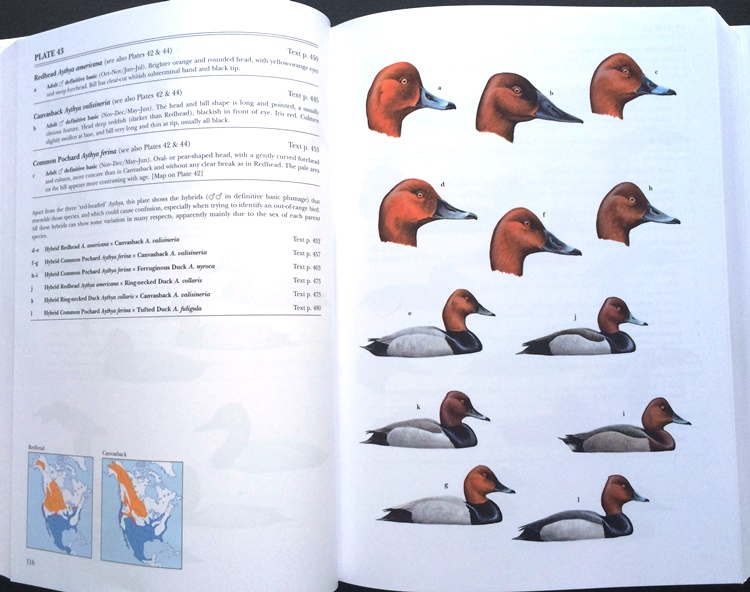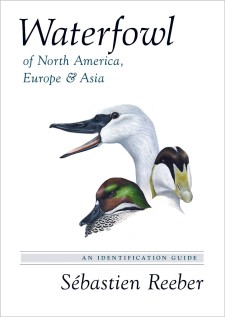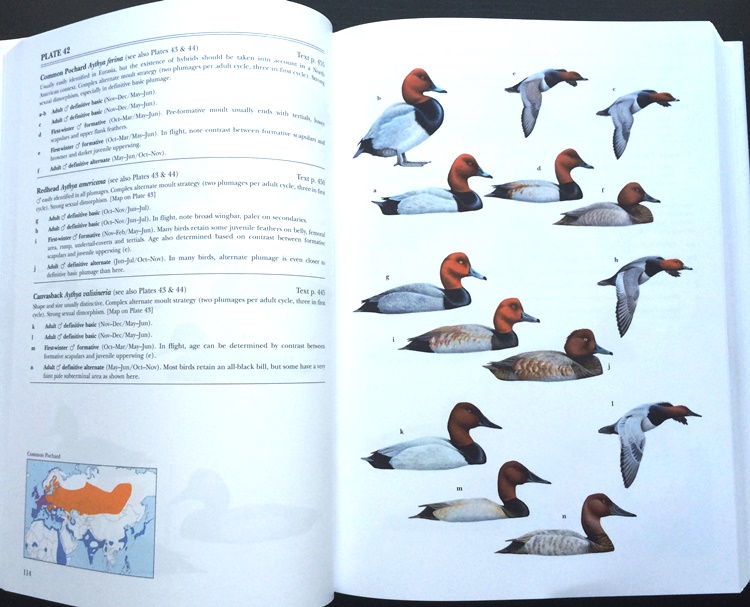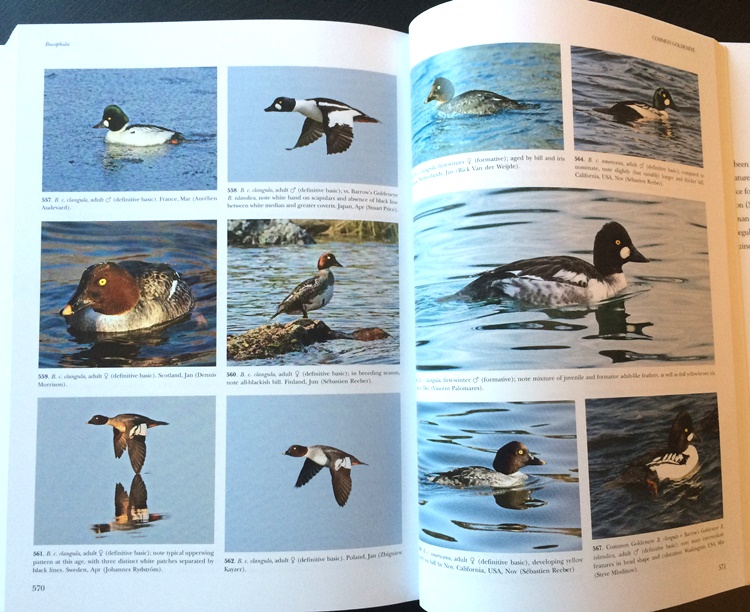Reviewed by Frank Lambert on May 15th, 2016.
Waterfowl of North America, Europe, and Asia: An Identification Guide is the definitive guide for anyone who wants to identify the ducks, geese, and swans of the Holarctic. The book provides exhaustive coverage of 83 species of ducks, geese, and swans that are distributed in North America, Europe, and most of Asia. This is a meticulously researched piece of work that has, incredibly, been both written and illustrated by Sébastien Reeber. It is a very impressive piece of work; within it is a wealth of information on how to identify any of the waterfowl you are likely to encounter within the region covered. The species accounts are truly comprehensive and fully referenced, and embedded within them are numerous high-quality photos that illustrate key features and variations. The plates, too, appear comprehensive since they include a thorough treatment of hybrids, something that has been inadequately covered by past publications on the Anseriformes. However, it should be noted that this is a heavy volume, designed more for use at home or in a vehicle rather than for carrying into the field.
Most books of this type are introduced by a set of short chapters that introduce the reader to various aspects of the bird group covered, such as aspects of taxonomy and evolution, habitats, food and foraging, breeding behaviour, migration and movements, and threats and conservation. This book, however, deviates from the norm. Following a short chapter entitled How to Use this Book, we find a brief discussion of Taxonomy and Systematics and Avian Topography. These are followed by highly detailed explanations of Moult and Plumages, Age and Sexing, and Hybridisation, all of which are extremely important to anyone wanting to identify ducks. Following this, we find the first species account.
Whilst it would seem perfectly acceptable to keep all information on breeding, foraging, habitat, etc. within the species accounts, especially since this is an Identification Guide, one of the drawbacks of deviating from the typical format seems to be that the author has forgotten to clearly define the region covered by this guide. From the title, one might suppose that this book covers all of the ducks that occur in Asia, but in fact the boundaries would appear to be ambiguous. Whilst both White-winged Duck Asarcornis scutulata and Comb Duck Sarkidiornis melanotos are included, Pink-headed Duck Rhodonessa caryophyllacea (which once also occurred in some of the very same areas, and may still do so) is not. Although it could be argued that Rhodonessa is left out because it is probably extinct, this falls flat when one considers that Crested Shelduck Tadorna cristata, which seems far less likely to be extant than Pink-headed Duck, is included in this book. This aside, it is clearly misleading to use Asia in the title of the book, since it does not cover all the waterfowl of Asia. Apart from Pink-headed Duck, species that are clearly Asian by most definitions, such as Philippine Mallard Anas luzonica, Andaman Teal Anas albogularis, and Sunda Teal Anas gibberifrons are also omitted. To learn about the identification of these species you will have to refer to other regional guides, or even to Helm’s original publication on the Anseriformes, Madge and Burn’s Wildfowl: an Identification Guide (1988). In reality, this is a guide to the ducks, geese, and swans of the Holarctic, with a couple of additions from the Indian subcontinent.

You get both the regular views of the birds, plus close-ups of the heads and an extensive selection of hybrids.
In the introductory section, great emphasis is given to the moult and plumages section which goes into a level of detail rarely seen in books of this nature – the reason being that the key to the identification of many Holarctic Anseriformes lies in an understanding of moult, ageing, and plumage variation. Hence we are introduced to a clearly defined terminology relating to moult and plumage that is used throughout the book. This may not be familiar to many readers, and even somewhat intimidating, but it is certainly worth taking the time to read and you will inevitably have to refer back to this section when using the species accounts. The section on hybridisation in the introduction, which is illustrated by 24 excellent photos, is also worth paying attention to considering how many potential hybrid ducks and geese (and even swans) are reported by birders.
The bulk of the book comprises the plates and species accounts. The 72 plates present more than 920 paintings by the author, and these are supplemented with more than 650 superb photos that are found within the species accounts. Between them, they cover the 83 species in great depth, as well as an incredible 107 known hybrids that can be encountered in the wild. Each species account includes sections on taxonomy, identification, plumage (determination of age and sex), geographic variations, measurements, voice, moult, hybridisation, habitat and life-cycle, range and population, and captivity. Maps are to be found opposite the plates rather than within each species account.
The maps do not show the distribution of subspecies, but rather provide blanket coverage for the range of the species. For the majority of species this is completely adequate, but it would have been useful to have shown subspecies range for species that are treated differently in other taxonomic treatments. In this book, for example, all Bean Goose Anser fabalis taxa are treated as one species whereas in some global lists, such as IOC, they are split into two species – Taiga Bean Goose A. fabalis and Tundra Bean Goose A. serrirostris. Whilst Reeber provides the reader with his well-argued reasons for keeping these taxa together as one species, it would have been nice to have been able to see their putative distributions on the map, rather than to have had to try to piece it together from the laborious description of range.
As noted above, this book treats all Bean Geese as one species. On the other hand, White-winged Scoter Melanitta deglandi and Siberian Scoter M. stejnegeri are split from Velvet Scoter M. fusca, and Black Scoter M. americana is split from Common Scoter M. nigra. The book also recognises the splitting of Eastern Spot-billed Duck Anas zonorhyncha from Indian Spot-billed Duck A. poecilorhyncha, but not the splitting of Mexican Duck from Mallard A. platyrhynchos. Common Eider Somateria mollissima subspecies, including “Pacific Eider” S. m. v-nigrum, are all treated as one species. In general, the taxonomic decisions followed here are well-researched and presented, and there is a well-written and authoritative discussion relating to the confusing taxonomy of Brent Goose Branta bernicla (Brant Goose in IOC) as well as a comprehensive text for Canada Goose B. canadensis and Cackling Goose B. hutchinsii that illustrates the problematic questions posed by the taxonomy of the white-cheeked goose complex.
That the guide is well-researched can easily be seen by a perusal of the text and by the sheer number of references cited at the end – a phenomenal 1,396 in total. This is also the first bird guide that I have noticed that has credited a Flickr group, the Bird Hybrids Flickr Forum, and I would hope that more books will make use of the ever-increasing wealth of information available online. Accurately describing bird vocalisations on paper is surprisingly difficult, and it seems a pity that the author did not extend his online research to some of the freely-available recordings, such as those at Xeno-canto. References to specific recordings available online could easily point the reader to particular types of vocalisation for the majority of species covered in this book.
Despite a few shortcomings alluded to above, Waterfowl of North America, Europe, and Asia: An Identification Guide is an unrivalled, must-have reference for any birder with an interest in the ducks, geese, and swans of the Holarctic. It is a meticulously detailed book for serious birders. Bringing together just about everything you’d need to know in order to identify the waterfowl of the Holarctic, this monograph will surely be the standard reference for its subject for a long time to come.
[Also published as Canards, Cygnes et Oies d’Europe, d’Asie et d’Amérique du Nord, Delachaux and Niesté, and as Wildfowl of Europe, Asia and North America, Helm Identification Guide series, Bloomsbury Publishing.]
– Reviewed by Frank Lambert








[…] The Birder’s Library […]